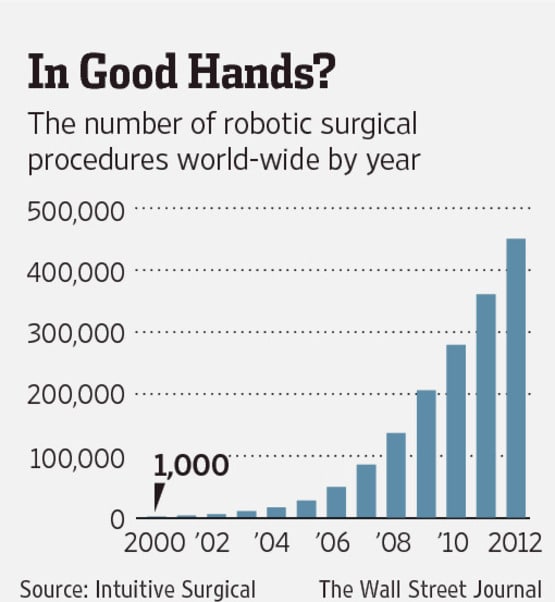The Pros and Cons of Robotic Surgery
Many patients are being injured by a new type of surgery: surgery by robot. More properly, these surgeries are robot-assisted, as a physician still maneuvers the robot.

Robotic surgeries are popular because, when everything goes well, they usually involve smaller incisions and less recuperation time. However, as the article below details, they are by no means risk-free. In fact, many patients have suffered health complications, or have even died, as a result of injuries caused by the robots.
This is an important lesson in buyer-beware, and anyone contemplating a robotic surgical procedure should be sure that they learn the single most important fact relevant to their decision: Exactly how much experience does the surgeon have performing THIS surgery with THIS device? No one should be afraid to ask such an elementary question. And no one should be afraid to say no if the answer is unsatisfactory. – PFS
The Pros and Cons of Robotic Surgery
What you should know before going under the remote-controlled knife
By Stewart Pinkerton, The Wall Street Journal
November 17, 2013
You need a hysterectomy, and the surgeon wants to do it robotically. Instead of working directly with his hands, he will sit at a console manipulating a set of robotic arms outfitted with tiny surgical instruments.
You’d be forgiven for some hesitation. There have been widely publicized horror stories, including patients who have bled out after a robotic instrument inadvertently nicked a blood vessel or those who have been injured in other ways, such as accidental punctures, tears or burns.
The rise of such “adverse events” during various robotic procedures has led to new government scrutiny, as well as a cautionary statement from the American College of Obstetricians and Gynecologists: “Robotic surgery is not the only or the best minimally invasive approach to hysterectomy…nor is it the most cost-effective.”
Does any of this warrant your flatly rejecting robotic surgery? Many experts say no. Every patient profile is different, and a robot is just another surgical instrument: It’s only as good as the surgeon using it.
Before making a decision on what kind of procedure to elect, here are some things to consider:
Why the spike in robotic usage?
Back in 2000, there were only 1,000 robotic surgeries world-wide. That number surged to 360,000 in 2011 and 450,000 last year. Boosters say the practice is on the rise because of its strong benefits. For the patient, there’s usually less blood loss, a shorter hospital stay and less reliance on postoperative pain medication. There’s also the cosmetic benefit of no big scars: As in laparoscopic surgery, the instruments enter the body through small incisions.
For surgeons, the procedures can be less tiring. They don’t have to bend over an operating table—they can sit in front of a screen with a magnified, full-color 3-D view of the surgical field. For maneuvering in very tight spaces, like the back of the throat, the enhanced screen image makes it “much easier to see what I’m doing,” says Eric Genden, chief of otolaryngology at New York’s Mount Sinai Hospital.
But some doctors say robotics is catching on not just because of its merits—there’s a “wow” factor at work. Martin Makary, a pancreatic surgeon at Johns Hopkins, believes the technique is safe and useful for certain procedures. But, he says, it’s spreading too fast. We have a “culture that marvels at new technology,” he says, and a propensity to embrace innovations “without a lot of rigorous, standardized evaluation.”
Some doctors also say there’s an arms race by hospitals eager to attract new patients and get a competitive edge. Highway billboards and websites sometimes suggest robots improve cancer outcomes, a claim that many doctors say isn’t backed up by studies.
Government officials have shown concern about oversight as well. For example, responding to an increasing number of reports of patient complications from robotic surgery, Massachusetts health officials last March sent an advisory to the state’s hospitals urging caution: “As with any new technology, care should be taken that protocols are in place to ensure appropriate patient selection and the full explanation of risks and benefits for all surgical options.”
What about risks?
Reports of adverse robotic events to the Food and Drug Administration are on the rise. Based on a draft analysis of these reports by physicians at Rush University Medical Center, the University of Illinois and the Massachusetts Institute of Technology, there has been a sharp increase in the injury and death rate from robotic surgery to about 50 reports per 100,000 procedures last year from only 13.3 in 2004…
